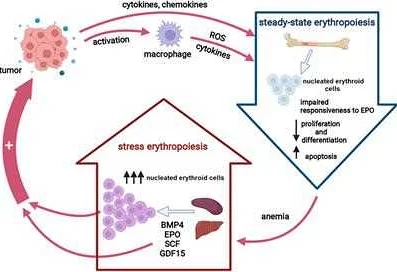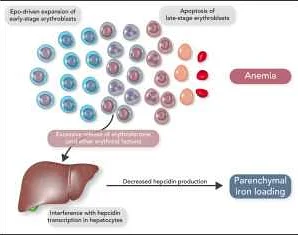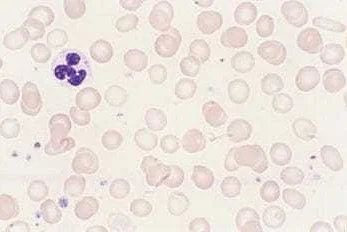Understanding Decreased Erythropoiesis: Causes, Symptoms, and Treatment
Learn about the causes and symptoms of decreased erythropoiesis, a condition that results in reduced red blood cell production. Understand how it can lead to anemia and the treatments available to manage this condition.
Decreased erythropoiesis, or a decrease in the production of red blood cells, is a condition that can have significant effects on an individual’s health and well-being. Red blood cells, also known as erythrocytes, are responsible for carrying oxygen from the lungs to the rest of the body. When erythropoiesis is decreased, the body may not have enough red blood cells to adequately supply oxygen to the organs and tissues.
Erythropoiesis is a complex process that occurs in the bone marrow. The production of red blood cells is regulated by a hormone called erythropoietin, which is produced by the kidneys. When the body detects a decrease in oxygen levels, it releases erythropoietin, which stimulates the bone marrow to produce more red blood cells. However, certain factors can disrupt this process and lead to decreased erythropoiesis.
There are several causes of decreased erythropoiesis, including:
– Nutritional deficiencies: A lack of essential nutrients, such as iron, vitamin B12, or folic acid, can impair erythropoiesis.
– Chronic diseases: Conditions like kidney disease, liver disease, and cancer can affect the production of red blood cells.
– Medications: Some medications, including chemotherapy drugs and certain antibiotics, can suppress erythropoiesis.
– Genetic disorders: Inherited conditions, such as thalassemia and sickle cell anemia, can cause decreased erythropoiesis.
Common symptoms of decreased erythropoiesis include fatigue, shortness of breath, weakness, pale skin, and dizziness. If left untreated, decreased erythropoiesis can lead to complications such as anemia, organ damage, and impaired immune function.
Treatment for decreased erythropoiesis depends on the underlying cause. In some cases, addressing nutritional deficiencies or managing chronic diseases may be sufficient to restore normal erythropoiesis. In other cases, medications such as erythropoietin-stimulating agents or blood transfusions may be necessary to increase red blood cell production. It is important for individuals experiencing symptoms of decreased erythropoiesis to consult with a healthcare professional for proper diagnosis and treatment.
In conclusion, understanding the causes, symptoms, and treatment options for decreased erythropoiesis is essential for maintaining optimal health. By identifying and addressing the underlying factors contributing to decreased erythropoiesis, individuals can take steps towards improving their overall well-being and preventing complications associated with this condition.
Main Causes Leading to Decreased Erythropoiesis

Erythropoiesis refers to the process of red blood cell production in the bone marrow. Decreased erythropoiesis, or reduced red blood cell production, can be caused by various factors. Some of the main causes leading to decreased erythropoiesis include:
1. Nutritional deficiencies: Inadequate intake of essential nutrients such as iron, vitamin B12, and folate can impair erythropoiesis. These nutrients play crucial roles in the production of healthy red blood cells.
2. Chronic diseases or medical conditions: Certain chronic diseases or medical conditions can affect erythropoiesis. Examples include chronic kidney disease, liver disease, autoimmune disorders, and certain types of cancer.
3. Medications: Some medications can interfere with red blood cell production. Chemotherapy drugs and certain antibiotics are known to have this effect.
4. Bone marrow disorders: Diseases that affect the bone marrow, such as aplastic anemia and myelodysplastic syndromes, can lead to decreased erythropoiesis.
5. Inherited conditions: Certain genetic disorders, such as thalassemia and sickle cell anemia, can impair erythropoiesis and result in decreased red blood cell production.
It is important to identify and address the underlying causes of decreased erythropoiesis to effectively manage the condition. Treatment options may include nutritional supplementation, medication adjustments, or more targeted therapies depending on the specific cause.
Common Symptoms Associated with Decreased Erythropoiesis

Decreased erythropoiesis, or a reduction in the production of red blood cells, can lead to various symptoms that indicate low levels of hemoglobin in the blood. These symptoms may vary depending on the severity of the condition and the underlying cause. Here are some common symptoms associated with decreased erythropoiesis:
- Fatigue: A constant feeling of tiredness and lack of energy is a common symptom of decreased erythropoiesis. This occurs because the body does not have enough red blood cells to transport oxygen to the tissues.
- Shortness of breath: When there is a decreased production of red blood cells, the body does not receive enough oxygen. As a result, individuals may experience difficulty in breathing, especially during physical activities or exertion.
- Dizziness: Insufficient red blood cells can lead to reduced oxygen supply to the brain, causing dizziness or lightheadedness. These symptoms may worsen when standing up quickly or after prolonged periods of sitting or lying down.
- Pale skin: Due to the lack of hemoglobin, which gives blood its red color, individuals with decreased erythropoiesis may have a pale or washed-out appearance. This symptom is often noticeable in the face, gums, and nail beds.
- Rapid or irregular heartbeat: In an attempt to compensate for the low levels of oxygen, the heart may beat faster or irregularly. This can result in a racing or pounding sensation in the chest.
- Cognitive difficulties: In severe cases of decreased erythropoiesis, oxygen deprivation to the brain may cause cognitive impairments such as difficulty in concentrating, memory problems, or confusion.
If you are experiencing any of these symptoms, it is important to consult a healthcare professional for a proper diagnosis and appropriate treatment.
Dangerous Consequences of Decreased Erythropoiesis
Decreased erythropoiesis, or the impaired production of red blood cells, can have serious consequences on the body and overall health. Without an adequate number of red blood cells, the body is unable to properly deliver oxygen to tissues and organs, leading to a condition known as hypoxia. Hypoxia can result in a range of dangerous consequences.
One of the most significant dangers of decreased erythropoiesis is the development of severe anemia. Anemia occurs when there is a decrease in the number of red blood cells or a decrease in the amount of hemoglobin, the protein that carries oxygen. The lack of oxygen can cause fatigue, weakness, shortness of breath, and dizziness. Severe cases of anemia can lead to organ damage and even death if left untreated.
Additionally, decreased erythropoiesis can have detrimental effects on the cardiovascular system. The heart works harder to compensate for the reduced oxygen-carrying capacity of the blood, leading to an increased risk of heart failure, high blood pressure, and other cardiovascular complications. The lack of oxygen delivery to the heart muscles can also result in chest pain, known as angina.
Decreased erythropoiesis can also impact the immune system. Red blood cells play a crucial role in transporting oxygen to the body’s immune cells, allowing them to function properly. Without an adequate supply of oxygen, the immune system may become weakened, making individuals more susceptible to infections.
In severe cases, decreased erythropoiesis can lead to tissue and organ damage due to chronic hypoxia. Organs such as the brain, kidneys, and liver are particularly vulnerable to damage from oxygen deprivation. Cognitive impairment, kidney failure, and liver dysfunction can occur as a result.
Overall, the dangerous consequences of decreased erythropoiesis highlight the importance of identifying and addressing the underlying causes of impaired red blood cell production. Timely diagnosis and appropriate treatment are essential to prevent further complications and improve the patient’s quality of life.
Diagnostic Methods to Identify Decreased Erythropoiesis

Erythropoiesis refers to the process by which red blood cells are produced in the bone marrow. When erythropoiesis is decreased, it can lead to anemia and other related conditions. Identifying the underlying cause of decreased erythropoiesis is crucial for effective treatment and management of these conditions.
There are several diagnostic methods that healthcare professionals use to identify decreased erythropoiesis:
1. Blood tests: Blood tests are commonly used to measure various parameters that can indicate decreased erythropoiesis. These include:
- Hemoglobin levels: Hemoglobin is a protein in red blood cells that carries oxygen. A decrease in hemoglobin levels can indicate decreased erythropoiesis.
- Reticulocyte count: Reticulocytes are immature red blood cells. A low reticulocyte count suggests decreased production of red blood cells in the bone marrow.
- Ferritin levels: Ferritin is a protein that stores iron in the body. A decrease in ferritin levels can indicate iron deficiency, which can contribute to decreased erythropoiesis.
2. Bone marrow aspiration and biopsy: In some cases, a healthcare professional may perform a bone marrow aspiration and biopsy to examine the bone marrow directly. This procedure can help assess the production and maturation of red blood cells and identify any abnormalities or disorders affecting erythropoiesis.
3. Genetic testing: Certain genetic mutations and disorders can cause decreased erythropoiesis. Genetic testing can help identify these mutations and provide valuable information for diagnosis and treatment planning.
4. Physical examination and medical history: A healthcare professional will typically conduct a physical examination and review the patient’s medical history to identify any potential causes of decreased erythropoiesis. This may involve assessing for signs of nutritional deficiencies, chronic diseases, or other underlying conditions that can affect red blood cell production.
Overall, diagnosing decreased erythropoiesis requires a comprehensive approach, combining blood tests, bone marrow examination, genetic testing, and clinical evaluation. By identifying the cause of decreased erythropoiesis, healthcare professionals can develop targeted treatment plans and provide appropriate management to improve erythropoiesis and alleviate associated symptoms.